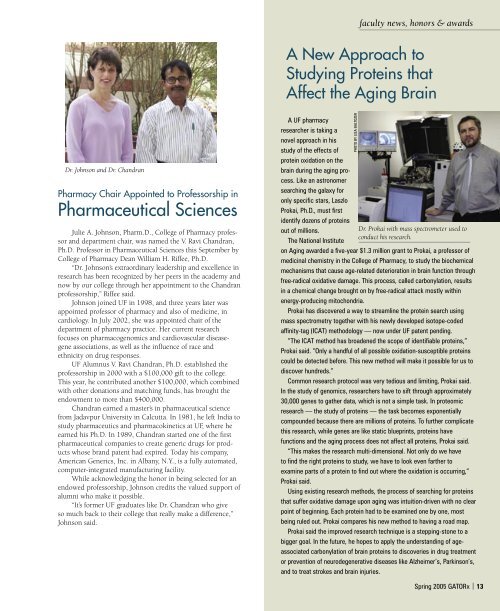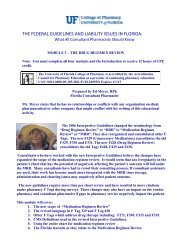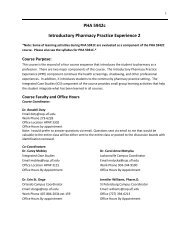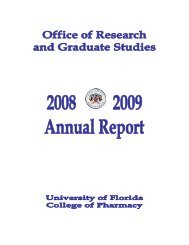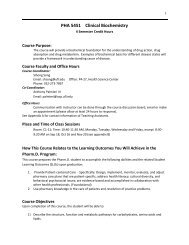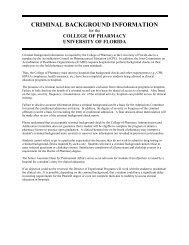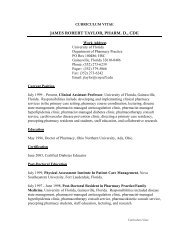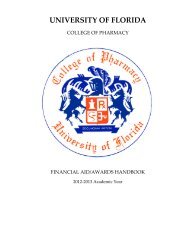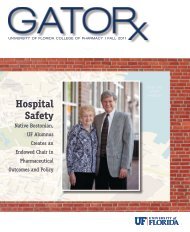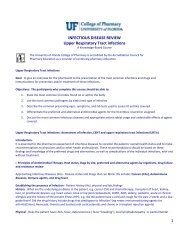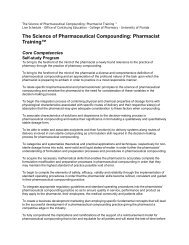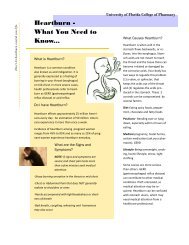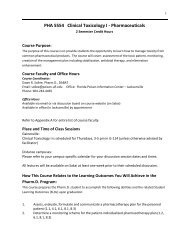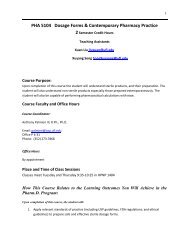GATORx W05.indd - College of Pharmacy - University of Florida
GATORx W05.indd - College of Pharmacy - University of Florida
GATORx W05.indd - College of Pharmacy - University of Florida
You also want an ePaper? Increase the reach of your titles
YUMPU automatically turns print PDFs into web optimized ePapers that Google loves.
Dr. Johnson and Dr. Chandran<br />
<strong>Pharmacy</strong> Chair Appointed to Pr<strong>of</strong>essorship in<br />
Pharmaceutical Sciences<br />
Julie A. Johnson, Pharm.D., <strong>College</strong> <strong>of</strong> <strong>Pharmacy</strong> pr<strong>of</strong>essor<br />
and department chair, was named the V. Ravi Chandran,<br />
Ph.D. Pr<strong>of</strong>essor in Pharmaceutical Sciences this September by<br />
<strong>College</strong> <strong>of</strong> <strong>Pharmacy</strong> Dean William H. Riffee, Ph.D.<br />
“Dr. Johnson’s extraordinary leadership and excellence in<br />
research has been recognized by her peers in the academy and<br />
now by our college through her appointment to the Chandran<br />
pr<strong>of</strong>essorship,” Riffee said.<br />
Johnson joined UF in 1998, and three years later was<br />
appointed pr<strong>of</strong>essor <strong>of</strong> pharmacy and also <strong>of</strong> medicine, in<br />
cardiology. In July 2002, she was appointed chair <strong>of</strong> the<br />
department <strong>of</strong> pharmacy practice. Her current research<br />
focuses on pharmacogenomics and cardiovascular diseasegene<br />
associations, as well as the influence <strong>of</strong> race and<br />
ethnicity on drug responses.<br />
UF Alumnus V. Ravi Chandran, Ph.D. established the<br />
pr<strong>of</strong>essorship in 2000 with a $100,000 gift to the college.<br />
This year, he contributed another $100,000, which combined<br />
with other donations and matching funds, has brought the<br />
endowment to more than $400,000.<br />
Chandran earned a master’s in pharmaceutical science<br />
from Jadavpur <strong>University</strong> in Calcutta. In 1981, he left India to<br />
study pharmaceutics and pharmacokinetics at UF, where he<br />
earned his Ph.D. In 1989, Chandran started one <strong>of</strong> the first<br />
pharmaceutical companies to create generic drugs for products<br />
whose brand patent had expired. Today his company,<br />
American Generics, Inc. in Albany, N.Y., is a fully automated,<br />
computer-integrated manufacturing facility.<br />
While acknowledging the honor in being selected for an<br />
endowed pr<strong>of</strong>essorship, Johnson credits the valued support <strong>of</strong><br />
alumni who make it possible.<br />
“It’s former UF graduates like Dr. Chandran who give<br />
so much back to their college that really make a difference,”<br />
Johnson said.<br />
A UF pharmacy<br />
researcher is taking a<br />
novel approach in his<br />
study <strong>of</strong> the effects <strong>of</strong><br />
protein oxidation on the<br />
brain during the aging process.<br />
Like an astronomer<br />
searching the galaxy for<br />
only specific stars, Laszlo<br />
Prokai, Ph.D., must first<br />
identify dozens <strong>of</strong> proteins<br />
out <strong>of</strong> millions.<br />
The National Institute<br />
faculty news, honors & awards<br />
A New Approach to<br />
Studying Proteins that<br />
Affect the Aging Brain<br />
PHOTO BY LISA BALTOZER<br />
Dr. Prokai with mass spectrometer used to<br />
conduct his research.<br />
on Aging awarded a five-year $1.3 million grant to Prokai, a pr<strong>of</strong>essor <strong>of</strong><br />
medicinal chemistry in the <strong>College</strong> <strong>of</strong> <strong>Pharmacy</strong>, to study the biochemical<br />
mechanisms that cause age-related deterioration in brain function through<br />
free-radical oxidative damage. This process, called carbonylation, results<br />
in a chemical change brought on by free-radical attack mostly within<br />
energy-producing mitochondria.<br />
Prokai has discovered a way to streamline the protein search using<br />
mass spectrometry together with his newly developed isotope-coded<br />
affinity-tag (ICAT) methodology — now under UF patent pending.<br />
“The ICAT method has broadened the scope <strong>of</strong> identifiable proteins,”<br />
Prokai said. “Only a handful <strong>of</strong> all possible oxidation-susceptible proteins<br />
could be detected before. This new method will make it possible for us to<br />
discover hundreds.”<br />
Common research protocol was very tedious and limiting, Prokai said.<br />
In the study <strong>of</strong> genomics, researchers have to sift through approximately<br />
30,000 genes to gather data, which is not a simple task. In proteomic<br />
research — the study <strong>of</strong> proteins — the task becomes exponentially<br />
compounded because there are millions <strong>of</strong> proteins. To further complicate<br />
this research, while genes are like static blueprints, proteins have<br />
functions and the aging process does not affect all proteins, Prokai said.<br />
“This makes the research multi-dimensional. Not only do we have<br />
to find the right proteins to study, we have to look even farther to<br />
examine parts <strong>of</strong> a protein to find out where the oxidation is occurring,”<br />
Prokai said.<br />
Using existing research methods, the process <strong>of</strong> searching for proteins<br />
that suffer oxidative damage upon aging was intuition-driven with no clear<br />
point <strong>of</strong> beginning. Each protein had to be examined one by one, most<br />
being ruled out. Prokai compares his new method to having a road map.<br />
Prokai said the improved research technique is a stepping-stone to a<br />
bigger goal. In the future, he hopes to apply the understanding <strong>of</strong> ageassociated<br />
carbonylation <strong>of</strong> brain proteins to discoveries in drug treatment<br />
or prevention <strong>of</strong> neurodegenerative diseases like Alzheimer’s, Parkinson’s,<br />
and to treat strokes and brain injuries.<br />
Spring 2005 <strong>GATORx</strong> | 13


